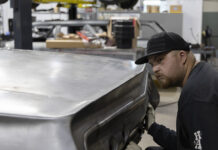This 1956 Chevy 210 Took Home Top Honors at the 2023 Danchuk Tri-Five Nationals
By Brian Brennan – Photography by John Jackson
Oftentimes the “beauty” of any hot rod lies in the subtleness of the build. It can be said that the key to constructing a good-looking hot rod for the street, regardless of year, make, or model, rests in your eluding the exaggeration of the build. We believe this can be applied to George Lange of St. Louis, Missouri’s 1956 Chevy 210. It was built under the care of Bobby Alloway at Alloway’s Hot Rod Shop. The subtle yet eye-catching build was also noted by the judges at the Danchuk Tri-Five Nationals this past year. While in Bowling Green, Kentucky, the panel selected this ’56 as the Tri-Five of the Year. It was literally selected from a field of thousands to take home the honors.
As is the customary practice at Alloway’s, this ride was to have an ample supply of rubber resting under all four quarters. To do this the rear truck area features modified wheel tubs while in front the inner fender panels also received a “massage.” Corner appointments include the combination of Alloway wheels and Goodyear rubber. The 17×7 and 20×10 highly polished slotted custom wheels made by Billet Specialties for Alloway. Next up the Goodyear rubber comes in 225/50R17 in front and 275/55R20 in the rear. While the sideview is sans badging, the hood and decklid feature what would be stock factory jewelry. While not immediately “visible” (but Tri-Five fans will see this) the front and rear bumpers were tucked into the body, leaving a much more pleasant look. Although not visible, interior floor sheet metal needed some reworking to allow for the transmission swap to the new TREMEC TKX 5 speed manual transmission. Externally the sheetmetal is stock in its appearance, although side badging was removed. Front and rear badging was retained. If you know Alloway-built hot rods, then the color of choice is black. Well, almost. It appears longtime customer George knew the “secret combination” to have his 1956 Chevy painted in white. All the body- and paintwork was handled at Alloway’s shop with the final color a PPG Deltron Chrysler White.
Read More: How to Install Heidts’ 4 Link Suspension On A Tri-Five (1955-1957) Chevy
In the ’90s General Motors produced a limited production run of 356-T6M aluminum ZL-1 big block Chevy with PN 12370850 (weighing approximately 110 pounds, which is 12 pounds heavier than the original block). There were also a handful of internal upgrades made to the block to make it even better. One such change was to convert the block from mechanical flat-tappet camshaft to a modern hydraulic roller ’stick.
It is one of these that Alloway used as the basis for the big block engine in this 1956 Chevy. The block carries the original casting number of 3946053 from the original tooling, which was also used. (It should be noted that the letter/number designation of ZL-1 was initially used with the original ’69 ZL-1 COPO Camaros. There were 69 made for Camaros and two for 1969 Corvettes. A word on the economics of a 1969 Corvette. The ZL-1 option cost $4,718.35 added to the base price of $4,781 for a 1969 Corvette. A little quick math and a hot rodder was looking at a total of $9,499 for a 1969 Corvette. Rare air for sure but there was nothing else around that could compare. The hyphen in ZL-1 was dropped when the ZL1 was used once again in 2012 on the fifth-generation Camaro.)
During the process Jeff Taylor Performance Engines was tapped to build the retro-looking 427 big-block filled with plenty of ARP bolts, MSD ignition, Taylor spark plug wires, a Powermaster starter, and a Vintage Air Front Runner. The amazingly good-looking stainless headers and exhaust system come from Barillaro Speed Emporium that also feature stainless Borla ProXS mufflers. You will immediately notice that the aluminum big block Chevy features ’68 aluminum heads (right down to the “snowflake” cast into the heads) as well as the aluminum Corvette intake manifold that holds the highly distinctive Corvette Holley Tri-power of the day.
From here the 500 hp big block engine is backed up to a TREMEC TKX 5 speed manual transmission. The American Powertrain Pro-Fit TKX transmission kit for any of the Tri-Five Chevys was used. Aside from the 5 speed manual transmission the kit comes with a transmission crossmember, polyurethane mount, driveshaft, slip yoke, pilot bearing, shifter mechanism, shifter knob, and other hardware.
Read More: This LS Swapped Tri-Five Chevy Is a Sleeper Hot Rod
Working all this power rearward it finally arrives at a Currie 9 inch rear end with 35-spline axles, 3.70 gears, limited-slip Truetrac differential, and drum brakes. Wrapping up the remainder of the rear suspension is a Ridetech four-link with their coilovers and an Alloway-fabricated Panhard bar. The front suspension is based on Heidts tubular arms, dropped spindles, coilover shocks, and Wilwood brakes based on 11-inch rotors with four-piston calipers. The entire brake package is operated through a Wilwood master cylinder and factory pedals.
Inside the Tri-Five Chevy it looks stock, and while much of it is, upon closer inspection, you will see a handful of changes. Let’s start with the stock dash, which is now outfitted with Classic Instruments Bel Era III direct fit (with Alloway’s Hot Rod Shop’s logo printed in the center face of the speedometer), including a Classic Instruments clock while retaining all the vintage gauge look. The new Bel Era III gauges feature all-electric technology that’s now implemented. Moving on, while it appears to be a factory AM radio it is and isn’t. R&B Vintage Radio retains the desirable factory look but turns the ’50s radio in an AM/FM stereo with auxiliary input, four channels with 45 watts per channel, Bluetooth, a USB port, and voice command. The original controls and tuner are retained but they control all the new features. As for the steering column it is a tilt ididit steering column with a leather-wrapped two-spoke Lecarra steering wheel. One more look will reveal that the factory heater/defroster controls are really the latest from Vintage Air as it operates the Gen IV SureFit system. As for the stitchwork, a name we are familiar with, Steve Holcomb of Pro Auto Custom Interiors, handled the chores. The stock front bench seat was retained while Holcomb fabricated a new rear seat and then covered both in blue leather by Moore & Giles. The same leather was used for the door and kick panels. The white headliner is a stock-looking perforated insert while the carpeting is a blue Daytona weave to match the blue used elsewhere inside.
Read More: The Forgotten Tri-Five Chevy
There’s no question how popular any of the Tr-Five cars are among hot rodders. While it’s long been the ’57 or possibly the ’55 as the most popular there’s no denying that the much-forgotten ’56 has come on strong. We are seeing more and more of the middle “sister” gaining in popularity. MR




















































